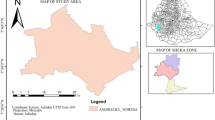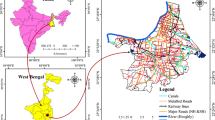Abstract
Geospatial data analytical model is developed in this paper to model the spatial suitability of malaria outbreak in Vellore, Tamil Nadu, India. In general, Disease control strategies are only the spatial information like landscape, weather and climate, but also spatially explicit information like socioeconomic variable, population density, behavior and natural habits of the people. The spatial multi-criteria decision analysis approach combines the multi-criteria decision analysis and geographic information system (GIS) to model the spatially explicit and implicit information and to make a practical decision under different scenarios and different environment. Malaria is one of the emerging diseases worldwide; the cause of malaria is weather & climate condition of the study area. The climate condition is often called as spatially implicit information, traditional decision-making models do not use the spatially implicit information it most often uses spatially explicit information such as socio-economic, natural habits of the people. There is need to develop an integrated approach that consists of spatially implicit and explicit information. The proposed approach is used to identity an effective control strategy that prevents and control of malaria. Inverse Distance Weighting (IDW) is a type of deterministic method used in this paper to assign the weight values based on the neighborhood locations. ArcGIS software is used to develop the geospatial habitat suitability model.















Similar content being viewed by others
References
Al-Harbi KMAS (2001) Application of the AHP in project management. Int J Proj Manag 19(1):19–27
Bellman RE, Zadeh LA (1970) Decision-making in a fuzzy environment. Manag Sci 17(4):B-141
Berke O (2004) Exploratory disease mapping: kriging the spatial risk function from regional count data. Int J Health Geogr 3:18
Broekhuizen H, Groothuis-Oudshoorn CG, Til JA, Hummel JM, IJzerman MJ (2015) A review and classification of approaches for dealing with uncertainty in multi-criteria decision analysis for healthcare decisions. PharmacoEconomics 33(5):445–455
Brugger, K., Boehnke, D., Petney, T., Dobler, G., Pfeffer, M., Silaghi, C., ... & Pfister, K. (2016). Modeling/GIS, Risk Assessment, Economic Impact A Density Map of the Tick-Borne Encephalitis and Lyme Borreliosis Vector Ixodes ricinus (Acari: Ixodidae) for Germany.
Chandio IA (2011) GIS-based multi-criteria decision analysis of land suitability for hillside development. Intern J Environ Sci Develop 2(6):469–473
Chen F-W, Liu C-W (2012) Estimation of the spatial rainfall distribution using inverse distance weighting (IDW) in the middle of Taiwan. Paddy Water Environ. doi:10.1007/s10333-012-0319-1
Chowell G, Towers S, Viboud C (2012) The influence of climatic conditions on the transmission dynamics of the 2009 a/H1N1 influenza pandemic in Chile. BMC Infect Dis 12:298
De SK, Biswas R, Roy AR (2001) An application of intuitionistic fuzzy sets in medical diagnosis. Fuzzy Sets Syst 117(2):209–213
Gillenwatera D, Granataa T, Zikab U (2006) GIS-based modeling of spawning habitat suitability for walleye in the Sandusky River. Ohio, and implications for dam removal and river restoration ecological engineering 28:311–323
Hepinstall JA, Queen LLP, Jordan PA (1996) Application of a modified habitat suitability lndex model for moose. Photogramm Eng Remote Sens 62(11):1281–1286
Hightower JE, Harris JE, Raabe JK, Brownell P, Ashton Drew C (2012) A Bayesian Spawning Habitat Suitability Model for American Shad in Southeastern United States Rivers. J Fish Wildlife Manag 3(2):184 www.fwspubs.org
Hongoh V, Hoen AG, Aenishaenslin C, Waaub J-P, Belanger D, Miche P (2011) Spatially explicit multi-criteria decision analysis for managing vector-borne diseases. Int J Health Geogr 10:70
Jato-Espino D, Castillo-Lopez E, Rodriguez-Hernandez J, Canteras-Jordana JC (2014) A review of application of multi-criteria decision making methods in construction. Autom Constr 45:151–162
Johnston KM, Graham E (2008) ArcGIS spatial analyst suitability modeling. ESRI User Conference, August 4-8
Lauver CL, Busby WH (2002) Testing a GIS model of habitat suitability for a declining grassland bird. Environmental Management 30(1):88–97, Springer-Verlag New York Inc
Lopez D, & Gunasekaran, M (2015). Assessment of vaccination strategies using fuzzy multi-criteria decision making. In proceedings of the fifth international Conference on fuzzy and Neuro computing (FANCCO-2015) (pp. 195-208). Springer.
Lopez D, & Manogaran, G. (2016). Big data architecture for climate change and disease dynamics, Eds. Geetam S. Tomar et al. the human element of big data: issues, analytics, and performance, CRC press.
Lopez D, Sekaran G (2016) Climate change and disease dynamics-a big data perspective. Int J Infect Dis 45:23–24
Lopez D, Gunasekaran, M, Murugan, B S, Kaur, H, & Abbas, KM (2014). Spatial big data analytics of influenza epidemic in Vellore, India. In big data (big data), 2014 I.E. international Conference on (pp. 19-24). IEEE.
Lu GY, Wong DW (2008) An adaptive inverse-distance weighting spatial interpolation technique. Comput Geosci 34(9):1044–1055
Lu ST, Lin CW, Ko PH (2007) Application of analytic network process (ANP) in assessing construction risk of urban bridge project. In: Second International Conference on Innovative Computing, Information and Control (ICICIC 2007). Second International Conference on. IEEE, Kumamoto, p 169–169
Macpherson MF, Davidson RS, Duncan DB, Lurz PW, Jarrott A, White A (2016) Incorporating habitat distribution in wildlife disease models: conservation implications for the threat of squirrelpox on the isle of Arran. Anim Conserv 19(1):3–14
Maharjan B, Shahnawaz, T. B., & Shrestha, P. M. (2017). Geo-spatial analysis of habitat suitability for common leopard (Panthera pardus Linnaeus, 1758) in Shivapuri Nagarjun National Park, Nepal
Manogaran G, Lopez D (2016) Health data analytics using scalable logistic regression with stochastic gradient descent. Intern J Advan Intell Parad 8(2):1–15
Manogaran G, Lopez D (2017) Disease surveillance system for big climate data processing and dengue transmission. Intern J Ambient Comp Intell (IJACI) 8(2):88–105
Manogaran G, Lopez D (2017) Spatial cumulative sum algorithm with big data analytics for climate change detection. Comput Electr Eng 60(2):1–25
Manogaran G, Thota C, Kumar MV (2016) MetaCloudDataStorage architecture for big data Security in cloud computing. Procedia Comp Sci 87:128–133
Manogaran, G Thota, C Lopez, D Vijayakumar, V Abbas, KM & Sundarsekar, R (2017). Big data knowledge system in healthcare. In Internet of Things and Big Data Technologies for Next Generation Healthcare (pp. 133–157). Springer International Publishing.
Manogaran G, Thota C, Lopez D (2017) Big data Security Intelligence for healthcare industry 4.0, Cybersecurity for Industry 4.0, edited by: lane Thames and Dirk Schaefer, Springer international publishing
Manogaran G, Thota C, Lopez D, Abbas KM (2017) “big data analytics in healthcare Internet of Things”, Innovative Health Systems for the 21st Century, Edited by, Hassan Qudrat-Ullah and Peter Tsasis, Springer-US
Massad E, Burattini MN, Ortega NR (1999) Fuzzy logic and measles vaccination: designing a control strategy. Int J Epidemiol 28(3):550–557
Narouei-Khandan HA, Halbert SE, Worner SP, van Bruggen AH (2016) Global climate suitability of citrus huanglongbing and its vector, the Asian citrus psyllid, using two correlative species distribution modeling approaches, with emphasis on the USA. Eur J Plant Pathol 144(3):655–670
Opricovic S, Tzeng GH (2007) Extended VIKOR method in comparison with outranking methods. Eur J Oper Res 178(2):514–529
Ozbek ME, de la Garza JM, Triantis K (2010) Efficiency measurement of bridge maintenance using data envelopment analysis. J Infrastruct Syst 16(1):31–39
Pavlovsky EN (1966) Natural Nidality of transmissible diseases with special reference to the landscape epidemiology of Zooanthroponoses. University of Illinois Press, Urbana
Phuong NH, Kreinovich V (2001) Fuzzy logic and its applications in medicine. Int J Med Inform 62(2):165–173
Rood E, Ganie AA, Nijman V (2010) Using presence-only modelling to predict, Asian elephant habitat use in a tropical forest landscape: implications for conservation diversity and distributions. Divers Distrib 16:975–984
Sarhangzadeh J, Yavari AR, Hemami MR, Jafari HR, Shams-Esfandabad B (2013) Habitat suitability modeling for wild goat (Capra aegagrus) in a mountainous arid area, central Iran Caspian. J Environ Sci 11(1):41–51
Şimşek B, İç YT, Şimşek EH (2013) A TOPSIS-based Taguchi optimization to determine optimal mixture proportions of the high strength self-compacting concrete. Chemom Intell Lab Syst 125:18–32
Thota C, Manogaran G, Lopez D, & Vijayakumar V (2017). Big data Security framework for distributed cloud data centers. In Cybersecurity Breaches and Issues Surrounding Online Threat Protection (pp. 288-310). IGI global.
Wang J, Xu Y, Li Z (2009) Research on project selection system of pre-evaluation of engineering design project bidding. Int J Proj Manag 27(6):584–599
Wen J, Chang XW (2017) Success probability of the Babai estimators for box-constrained integer linear models. IEEE Trans Inf Theory 63(1):631–648
Wen J, Zhou Z, Wang J, Tang X, & Mo Q (2016). A sharp condition for exact support recovery of sparse signals with orthogonal matching pursuit. IEEE Transactions on Signal Processing.
Xiao H, Tian H, Lin X, Gao L, Dai X, Zhang X, Xu J (2013) Influence of extreme weather and meteorological anomalies on outbreaks of influenza A (H1N1). Chin Sci Bull 58(7):741–749
Yang M, Qian X, Zhang Y, Sheng J, Shen D, Ge Y (2011) Spatial Multicriteria decision analysis of flood risks in aging-dam Management in China: a framework and case study. Int. J. Environ. Res. Public Health 8:1368–1387
Zoccali P, Malacrinò A, Campolo O, Laudani F, Algeri GM, Giunti G, Palmeri V (2017) A novel GIS-based approach to assess beekeeping suitability of Mediterranean lands. Saudi Journal of Biological Sciences. doi:10.1016/j.sjbs.2017.01.062
Author information
Authors and Affiliations
Corresponding author
Rights and permissions
About this article
Cite this article
Varatharajan, R., Manogaran, G., Priyan, M.K. et al. Visual analysis of geospatial habitat suitability model based on inverse distance weighting with paired comparison analysis. Multimed Tools Appl 77, 17573–17593 (2018). https://doi.org/10.1007/s11042-017-4768-9
Received:
Revised:
Accepted:
Published:
Issue Date:
DOI: https://doi.org/10.1007/s11042-017-4768-9




